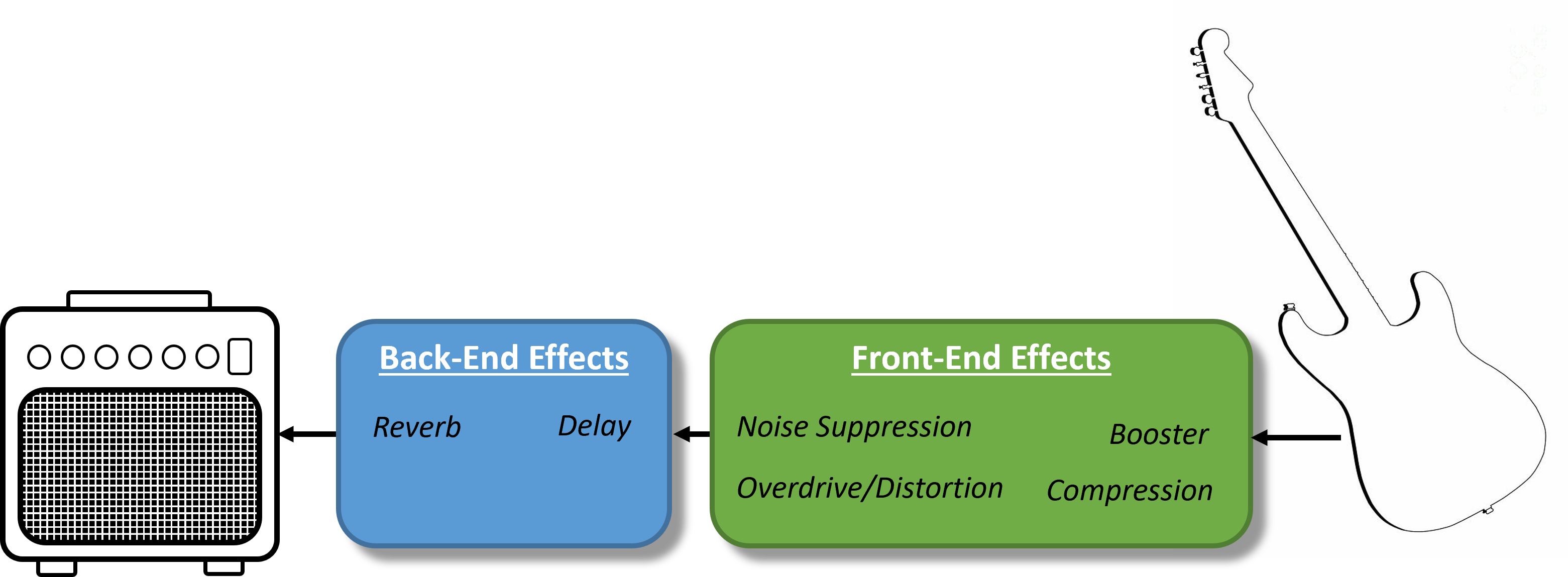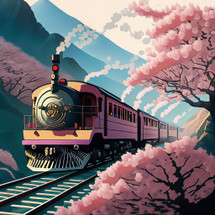Posted by Tony Romero on Sep 15th 2022
How to connect guitar pedals: what are Front-End effects and Back-End effects?
I’ve read a lot of blog posts about the topic of how to connect your guitar effect pedals. They always start by claiming “there is no wrong way to connect your pedals, be creative and explore your options!”. Ok, yeah, I get that. But if you get too creative, then what sounds good for one song, or one passage, may not sound good for other songs. So, let’s focus on the most practical way to connect effects that will sound great for most songs you are likely to play.
First off, most effects pedals are connected in “series”. That means the output of one effect is connected to the input of the next effect. It is very much like a train where you start with an engine (which is your guitar), then car 1, car 2, etcetera, and finally the caboose. You might also hear the term “effects chain” or "pedal chain" thrown about. So, what goes first? What is in the middle? What goes last?
Let’s simplify this into three main groups: Front-end, Middle, and Back-end.

Figure 1: Front-end, Middle, and Back-End effects chain
Front-end effects are first up in the chain. Your guitar is plugged into these pedals first. One thing to consider is that your guitar typically delivers a very weak signal. And that weak signal is usually traveling through a long guitar cable. So, the first effects pedal needs to take a weak signal and boost it so that ultimately your amp is getting a nice strong input. Front-end effects are where you want to shape the sound coming from your guitar. These are the foundation of your sound and have the most impact. Other effects behind the front-end ones are adding slight nuances and embellishments to your sound.
- Booster: A guitar booster, often called a boost pedal or clean boost, is an unassuming device that plays a crucial role in a guitarist's rig. Its primary function is to increase the signal strength or amplitude of your guitar's output without significantly altering the tone. Your tone will improve greatly as your amp or other effects receives a stronger input signal.
- Overdrive/Distortion: Right behind the compressor, is the overdrive and/or distortion. Overdrive is an effect that adds a little bit of grit to your original sound. It gets its name for feeding a large amount of volume into an amp so that the amp distorts. As you crank up the overdrive, you get more and more distortion!
- Compression: We recommend starting with a compression effect, or “compressor”. It is designed to not only boost a weak signal but also to keep it constant. This means that every effect behind it gets a strong and level feed. You will sound steady-handed and will cut through a mix when playing with a band or other music. If you increase the compression, it will start to sustain like a violin and every other effect will just add beautiful color to it.
- Noise suppression: OK, so both the Compressor and Overdrive are boosting your sound. However, your guitar and cable are sending both a guitar sound and noise. Especially when you finish a song and the guitar sound is starting to fade in volume, you may start to hear noise in the background. You may have heard of guitars “feeding back”, squealing, or hissing. Well, when the compressor and overdrive are cranked up, they are trying to boost that noise, and that sounds awful! The noise suppressor can be set up to kill your signal once your guitar volume is fading and crosses a low volume threshold. Now your song ends and your guitar is quiet. Nice!
Middle effects provide embellishment to your guitar sound. And there are a lot of them! I won’t go into great detail here, but these effects are usually used in small doses to add a certain unique flavor to a passage of a song, intro, or solo, which makes them so much fun!
- Modulation effects are created when your
original sound is mixed with another one, changing the amplitude or frequency
to come up with a cool new sound. Some use a delay that changes over time
(expanding and contracting). There are many types out there, but the main ones
are phase shifter (or "phaser"), chorus, and flanger. A few good examples are:
- Eddie Van Halen used a phaser effect a lot in songs such as “Eruption” or in the intro of “Ain’t Talking Bout Love”
- Jimi Hendrix used a flanger in “Bold as Love”
- The Shondells “Crimson and Clover” used a tremolo effect to modulate the volume.
- EQ effects allow you to shape the frequency response. Sometimes a mid-boost is used to cut through the mix with a band- especially for solos. Most players run this after front-end effects to shape the EQ curve that you are feeding into the amplifier.
Back-End effects are at the “caboose” of your effects chain. They provide the finishing touches to your sound and are typically trying to make your guitar sound natural or full. If your amplifier has an "Effects Loop" option, your Back-End effects can go here- before the final amplifying stage of the amp.
Back-End effects are time-based, so let me explain what this means. In the real world, sound travels around a space, bouncing off walls, floors, your nose, and ceilings, and then finally to your ears; your hearing can detect the time lags between an original sound coming directly from the amp and the sound bouncing off the wall- and this is what I mean by time-based. Another time-based situation occurs when two musicians are playing the same thing, but their timing is slightly out-of-synch (one musician is playing slightly delayed than the other). What makes this sound great, is that the sound “fattens” up and sounds fuller and more interesting.
A good rule of thumb for Back-end effects! Mix your "dry" signal with a "wet" signal. A "dry" signal is the sound coming into the input of the effect, while the "wet" signal is the sound with the effect. By mixing these two, you get clarity from the "dry" signal. If you add too much of the "wet" signal, it may start to drown out the original signal. Fortunately, the HandleBox ARTIE pedal lets you mix your "dry" and wet" signals!
- Reverb: This effect mimics the reverberation you get in a room as the sound bounces off walls and floors. The size of the room matters! In a bedroom, the sound bounces off walls quickly and the reverb is very subtle. In a concert hall, the room is massive, and sound can take a long time to bounce off the walls and you hear a much more pronounced reverb.
- Delay: This effect provides a digital delay to make your guitar sound fuller. Using short delays, it can sound like two players playing slightly out of synch to get you a fat sound. Country players typically use a slapback delay, a very short delay to sound like a fast echo with only one repeat. Most rock and blues players use a slight delay with 2-3 repeats to fatten up their guitar sound, usually for intros or solos. And on the more extreme side, The Edge from U2 uses multiple delays with varying timings and repeats to get a very complex rhythmic pattern!
We here at HandleBox(TM) Pedals have developed the Perfect Pedal Set to give you all the Front-end and Back-end effects you need for a wide range of guitar sounds. This bundle includes everything you need between your guitar and the amp to play right "out-of-the-box”. Our multi-effect pedals are easily mounted together with the included BASE BOOTs. Along with CODY’s integrated handle, it is an innovative way to eliminate costly pedalboards and make transportation a cinch!

